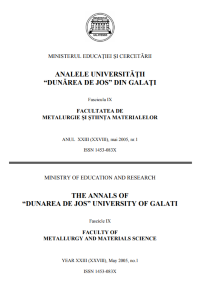Possibilities to Study the Mixing State and Energy Dissipation in Metallurgical Reactors Using a System Based on Coloured Liquids
Abstract
Coloured liquids are used to show the stream lines in aqueous systems used as model liquids, in different chemical reactors, also in metallurgical reactors dedicated to liquid steel processing; ladles represent a class where these principles could be succesful applied.
A blue ink was selected as colouring agent because of the low price, good biological tolerability in contact with the human skin and absence of the necessity to treat the used evacuated water.
As modeling liquid for stee was selected freshly distilled waterl.
Mixing energy dissipation was measured at adequate scales using the transmittance and the absorbance of liquid sampleswith two laboratory spectrocolorimeters (KFK-2 Russia and Spekol-10 Carl Zeiss Jena, Germany). Volumic relative concentrations of the coloured liquids starting with 0.0005%vol. and even bellow are measured using this technique and the mentioned devices.
Two model vessels, representing two types of metallurgical reactors, were usd in the present set of experiments. The experimental systems provide enough precise data because of using an adequate and accesible system of image recording and capture, based on a performant commercial web video camera.
Downloads
References
[2]. Wabo E, Mann R. “Using Reactive Tracers To Probe MacroMixing and Macro-Segregation in a plant-Scale Stirred Vessel, p 1-16. ” The 7th Conference of Mixing Fluid Mixing 7, 10-11 July 2002, University of Bradford, UK.
[3]. Ding R., Revstedt J., Fuchs L. “ LIF Study of Mixing in Circular Impinging Jets Effects of Boundary Conditions”, Proceedings of PSFVIP – 4, June 3-5, 2003 Chamonix, France, p. 1-13.
[4]. Wabo E., Kagoshima M., Mann R. “ Batch Stirred Vessel Mixing Evaluated by Visualised Reactive Tracers and Electrical Tomography.” Chemical Engineering Research and Design vol. 82, Issue A9, Sept 2004, p. 1229-1236.
[5]. Zhao D., Müller-Steinhagen H., Smith J.M. “New Reaction Pair For Micro-mixing Measurements in Gaz-Liquid Systems with Large Vapour Generation.” The 7th Conference of Mixing Fluid Mixing 7, 10-11 July 2002, University of Bradford, UK.
[6]. Bujalski J.M., Jaworski Z., Bujalski W., Nienow A.W. “The Influence of the Addition Position of a Tracer on CFD Simulated Mixing Times in a Vessel Agitated By a Rushton Turbine”, The 7th Conference of Mixing Fluid Mixing 7, 10-11 July 2002, University of Bradford, UK.
[7]. Bolton G.T., Oin C.H., Wang M. “A Novel Electrical Tomography Sensor For Monitoring The Phase Distribution in Industrial Reactors.” The 7th Conference of Mixing Fluid Mixing 7, 10-11 July 2002, University of Bradford, UK.
[8]. Melton A. L, Lipp C.W., Spradling R.W., Paulson K.A., “DIMST-Determination of Mixing Time through Color Changes”, Chemical Engineering Communmications (2001).
[9]. Mazumdar D., Evans J.W., “Macroscopic Models for Gas Stirred Ladles” ISIJ International, vol. 44(2004), no. 3, p. 447-461.



